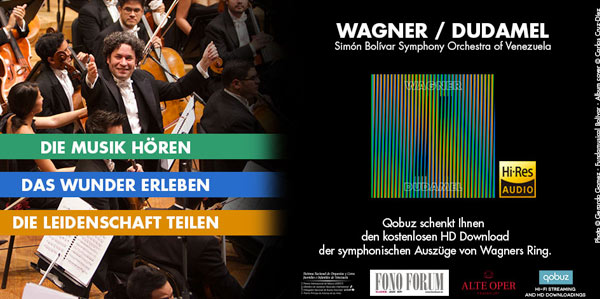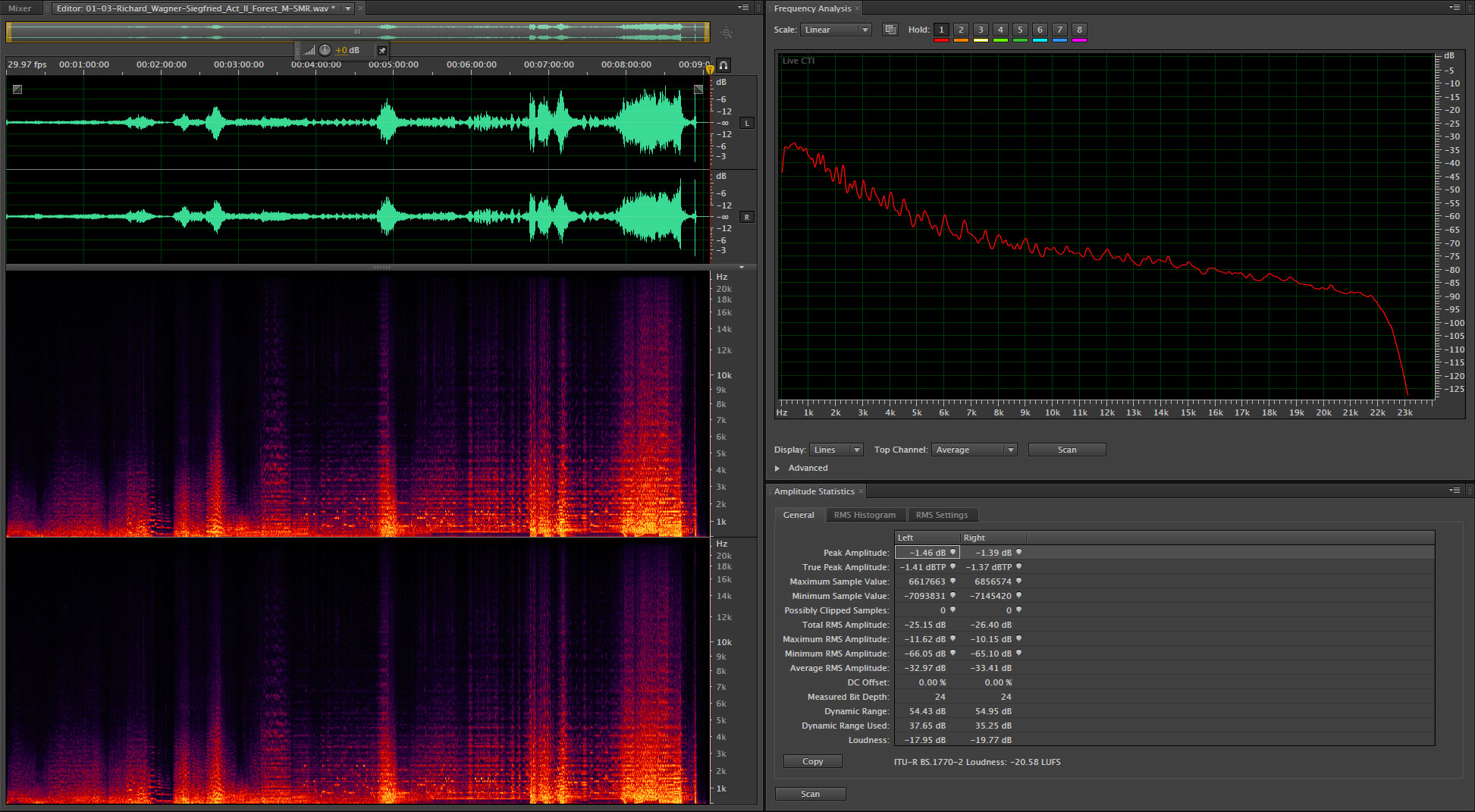QoBuz and the Hi-Res Audio Logo
A reader pointed out that the German version of the QuBuz website is running a promotion for a new “high-res audio” orchestral album that features the JAS “Hi-Res Audio” logo in the graphic that accompanies the promotion. This is the first time I’ve seen the logo used for a piece of content, which happens to be the music of Richard Wagner conducted by Gustavo Dudamel and the Simón Bolívar Symphony of Venezuela. The MusicBiz and CEA info graphic that I referred to in a recent post associated the logo with the DEG, CEA, and NARAS definition of high-resolution audio BUT then showed hardware companies that are selling equipment that meets the JAS requirements for the logo. Here’s the graphic:
Figure 1 – The JAS High-Res Audio logo used on the QoBuz website.
I’m actually planning on requesting a license to use the logo for my own label and iTrax website. There is some discussion inside of the organizations that the JAS logo only applies to hardware. Then why is it included on PowerPoint slides at the recent CES panel sessions and used on the info graphic. Doesn’t it make sense to lock down one logo and use it consistently across the entire spectrum of products…at least ones that meet or exceed the requirements as defined by the JAS? I think it does. And I know my recordings meet those requirements so why shouldn’t I sign up with the JAS, pay the $500, and benefit from the growing awareness of the logo? But it seems QoBuz got there first. The CEA has recently communicated that its member companies can apply to use the logo. It will be administered by the JAS.
The members of the CEA are virtually all consumer electronics manufacturers. These are companies that build hardware. In fact, I’m not aware of any other record labels that are members. There might be some software companies but no one that is making content or offering it via downloads.
The QoBuz company may have made an application directly to the JAS. You don’t have to be a Japanese company in order to be a member. Maybe the JAS has already starting making the logo available to companies in the European Union. But if QoBuz were granted permission to use the logo on their site, I would imagine that the JAS would expect them to adhere to the standards (basically getting everything through the production chain with 40 kHz signal width or more). The item that I located and downloaded doesn’t meet the JAS standard. The expected licensing terms that I’ve seen floating around don’t mention any third party verification. If you say something meets the specs then no one will challenge you. It’s the honor system.
The Wagner recording is available in a variety of formats. I downloaded the WAV files and did a quick analysis in Adobe Audition. The sound is just slightly better then a CD. The dynamic range of the movement I examined was only 55 dB or about 10 bits. The frequency response extended to 23 kHz. You can take a look below:
Figure 2 – The spectra of the Wagner recording at 48/24. [Click to enlarge]
This is a very good recording. Lots of clarity and precision. It’s well balanced and a great performance of some amazing compositions. My own personal taste tends towards less reverb and much more intimacy but this is the traditional orchestral sound.
The recording would qualify for the DEG, CEA, and NARAS definition of high-resolution audio but it doesn’t qualify for the JAS logo. This is going to be a problem. Already, the folks that I’ve talked to at the organizations are looking for ways to bring everything into “alignment”. My guess is that means watering down the logo requirements as they apply to content. It’s the only way the logo will survive in the area of content.




For what it’s worth, I believe that QoBuz have some kind of arrangement with Sony these days: when I received one of the new (Hi-Res) Walkmans at the end of October, it came with a fairly generous QoBuz voucher.
Nevertheless, that logo (which is in itself a great piece of graphic design, IMHO) does look out of place on the above image—too large, for one thing.
The end of your post makes me think if “Open Source” recordings could ever catch on: the opportunity for the listener or radio station to set their own reverb and EQ !?
Thanks Chris…coupons and bundles abound in the world of high-resolution downloads. I’m pushing the idea to some of the very same manufacturers…except my stuff is real HD. I love the idea of metadata in files to modify them on the fly. We’ll see.
I was just wondering why any orchestral music sounded so..ghm..extremely displeasing to the ears, even at 192 kHz sample rate.
Here comes the answer: this music type {unlike the best one, typically referred to as ‘avant-garde’} is very sensitive to system’s impulse response so that it must be recorded at the highest possible sampling rate o otherwise it will never sound correct !
That also implies that although music can be recorded at 768 kHz sample rate to avoid filtering, yet prior to getting into the loudspeakers it must be astronomically upsampled by DAC’s reconstruction filter to provide decent impulse response.
Jay wrote: “it must be astronomically upsampled by DAC’s reconstruction filter to provide decent impulse response”
Maybe Jay’s using Google translate, just guessing here…
Last time I’m sucked in in replying to Jay. The reason orchestral music very often doesn’t sound right is usually the capabilities of one’s speakers in tandem with one’s amplification power, combined, of course, with one’s listening room which, more often than not, does not resemble a concert hall…
Here we go……
My comment – which actually was the first one on todays subject – has now been tugged in between a couple of other postings.
What wanted to say is, that I see this use (or misuse) of the logo as the first example of labelling anything, that is markered and sold as higres with a ‘trustworthy’ tag – no matter what the provenance might be.
It is simply easier to draw attention, if you have a fancy logo/sticker on your website.
I am sure we will see more of this in the future.
Isn’t the file at a 48 kHz sampling frequency? So, why bother doing any analysis? We know it has a steep antialiasing filter before 24 kHz, so can’t meet the JAS definition.
As for dynamic range, a distantly miked recording is never going to measure as well as your close miking techniques. Like most classical music lovers, I’ll trade the better numbers for a blending of sound and sense of space more akin to what I hear in the concert hall.
I’m not like most classical music lovers, I guess. Listening to a live performance from the best seat in the house can be utterly captivating but it pales to standing next to the conductor. When I played the Pine of Rome for the music director/conductor of the NJSO years ago in full immersive 5.1, he absolutely flipped out. He told me, “finally, finally a recording that sounds like real music!” and the faculty of the Colburn School for Performing Arts here in Los Angeles (the “Julliard” of the west coast) insisted on coming to the studio after one of their members told them about my recordings of chamber music. They were equally impressed.
I don’t think many classical music lovers would switch back to a traditional stereo CD after experiencing an immersive 5.1 surround recording in real HD. There certainly haven’t been any hold outs in my experience. But to each his or her own…I also include stereo mixes on my discs.
Dan Lavry: ‘DA’s do not generate narrow pulses (RZ signals – return to zero), because there is not much energy in narrow pulses. Instead, the DA output signal (before the analog anti imaging filter) is a NRZ signal (NRZ – not return to zero). The signal looks like “steps” (not like narrow pulses), and such signal does contain the needed energy to drive the analog filter. However, when you use NRZ signals without up-sampling, you lose some high frequencies. The flatness response is compromised.
You can see a plot in my web site, in a paper “Sampling, Oversampling, Imaging and Aliasing”.
Look at page 3 for a plot titled Sin(X)/X plots for X2,X4,X8 and X16.
http://www.lavryengineering.com/white_papers/sample.pdf
You can see that at X2 up-sampling you still lose around .8dB at 20KH. With X4 up-sampling, the loss is around .2dB at 22KHz. At X8 it is less then .1dB, at X16 the loss in a non issue…
The horizontal axis is frequency (0-320KHz). Your interest is mostly 0-22KHz (audible range), shown by the red line marked “22”. The vertical axis is dB loss in amplitude. The curve that drops fastest is the X2 up-sampling. At X16, you 3dB loss is all the way up near 320KHz, with hardly any loss at 20KHz.
True, one can compensate for the loss, but it takes a lot of DSP (signal processing). It is not possible to compensate well for the Sin(X)/X curve with analog circuits.
So the bottom line is: you do not want a DA without any up-sampling. You may not need to up-sample a lot, but you need some up-sampling to enable good filtering and flat response. Most DA’s today up-sample between X64 to X1024. This is overkill for flat response, and is very good from an analog filter standpoint. The reasons for up-sampling so much are is due to modern DA converter architectures such as sigma delta designs.’
Jay, I’ve read Dan’s paper a number of times.
I’m sure there are people who would argue the earth is flat AND quote an Einstein paper to prove it…